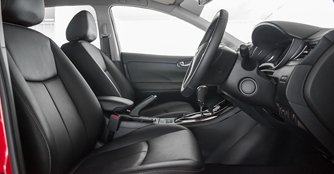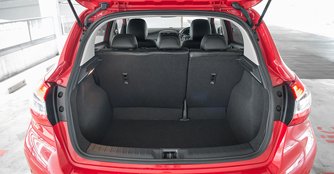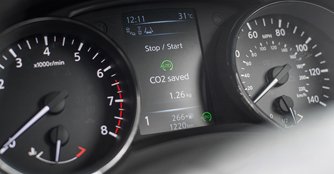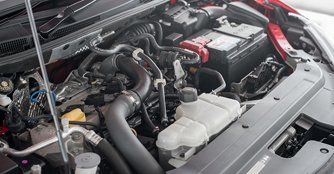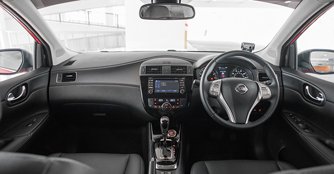Nissan Pulsar 1.2 DIG-T Premium (A) Review
10 Feb 2017|40,198 views
What We Like
Plenty of cabin space
Spacious 385-litre boot
Respectable 14km/L fuel economy
Useful safety features
What We Dislike
Plasticky materials throughout the cabin
Brake modulation can be improved
I wasn't around when the last iteration of the Nissan Pulsar hit our shores. However, if it was anything like the latest generation model that we drove recently, I'd reckon it would have been a pretty big hit.
The Nissan Pulsar 1.2 DIG-T is by no means a driver's car, nor is it the most luxurious. But considering factors such as increasing COE premiums and rising petrol prices, the Pulsar hits the spot for the average joe.
Paving the way for the everyday
Going up against the likes of the Volkswagen Golf and the Ford Focus, the Pulsar boasts practicality and everyday driveability in a relatively affordable package.
Nissan is offering the Pulsar in two trims. The Lite version comes in at $103,300 (as of 20th January 2017) while the Premium comes with leather upholstery and GPS navigation for an additional $3,000.
What impresses me the most is the Pulsar's cabin space. At over 1.8m tall, I've met my fair share of claustrophobic cars and unlike some of them, rear seats in the Pulsar don't require taller occupants to have contortionist-like flexibility.
The seats aren't too shabby either. The front row provides sufficient lumbar support for those long drives while leather upholstery in the Premium model we drove feels soft to the touch.
The Nissan Pulsar 1.2 DIG-T is by no means a driver's car, nor is it the most luxurious. But considering factors such as increasing COE premiums and rising petrol prices, the Pulsar hits the spot for the average joe.
Paving the way for the everyday
Going up against the likes of the Volkswagen Golf and the Ford Focus, the Pulsar boasts practicality and everyday driveability in a relatively affordable package.
Nissan is offering the Pulsar in two trims. The Lite version comes in at $103,300 (as of 20th January 2017) while the Premium comes with leather upholstery and GPS navigation for an additional $3,000.
What impresses me the most is the Pulsar's cabin space. At over 1.8m tall, I've met my fair share of claustrophobic cars and unlike some of them, rear seats in the Pulsar don't require taller occupants to have contortionist-like flexibility.
The seats aren't too shabby either. The front row provides sufficient lumbar support for those long drives while leather upholstery in the Premium model we drove feels soft to the touch.
Still, ventilated seats would have been a much nicer addition, as heated seats in our test car didn't do much to prevent us from spontaneously combusting in the Singapore heat.
Seating five full-grown adults in comfort isn't all this hatch can do, a 385-litre boot (five litres more compared to the Golf) ensures all your luggage is conveniently stowed away so your passengers can enjoy the ride.
If you're riding alone and require the additional space, the Pulsar's rear seats fold down to allow for a total of 1,395 litres of storage capable of accommodating anything from golf bags to a week's worth of groceries.
The comeback kid has a few tricks up its sleeve
A nifty little feature shows up on the Pulsar's 5.0-inch TFT information display every now and then in the form of a pop-up window, which displays the amount of accumulated CO2 saved due to the vehicle's auto start/stop function.
Nissan's Advanced Drive-Assist Display also allows fuel economy, average speed and audio information to be viewed at a quick glance.
Seating five full-grown adults in comfort isn't all this hatch can do, a 385-litre boot (five litres more compared to the Golf) ensures all your luggage is conveniently stowed away so your passengers can enjoy the ride.
If you're riding alone and require the additional space, the Pulsar's rear seats fold down to allow for a total of 1,395 litres of storage capable of accommodating anything from golf bags to a week's worth of groceries.
The comeback kid has a few tricks up its sleeve
A nifty little feature shows up on the Pulsar's 5.0-inch TFT information display every now and then in the form of a pop-up window, which displays the amount of accumulated CO2 saved due to the vehicle's auto start/stop function.
Nissan's Advanced Drive-Assist Display also allows fuel economy, average speed and audio information to be viewed at a quick glance.
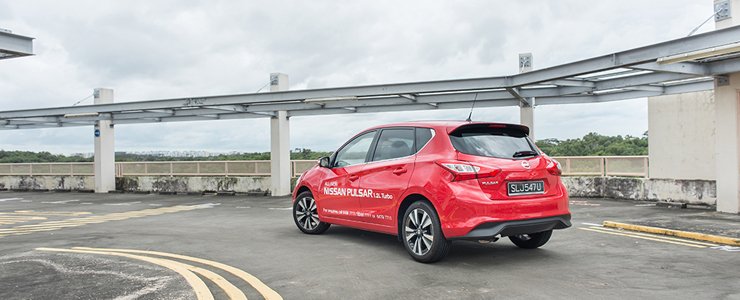 |
Speaking of savings, we managed to get an average fuel consumption figure of 14km/L out of its claimed 19.6km/L, which is a respectable figure in real-world conditions.
Staying alive for the daily drive
The Pulsar is not a particularly fun car to drive. It does, however, keep an eye out for you and your loved ones.
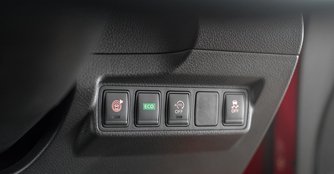
 Eco mode and an auto start/stop function help achieve the Pulsar's respectable 14km/L fuel consumption figure
Eco mode and an auto start/stop function help achieve the Pulsar's respectable 14km/L fuel consumption figure
Under Nissan's Safety Shield concept, the Pulsar boasts a total of six airbags (dual front, side and curtain), which come standard in both trims.
It also comes with Forward Emergency Braking, which detects potential obstacles directly in front of the car and assists in avoiding frontal collisions with pedestrians and vehicles.
Other standard safety features include Electronic Brake Force Distribution, Vehicle Dynamic Control and an Anti-lock Braking System with Brake Assist.
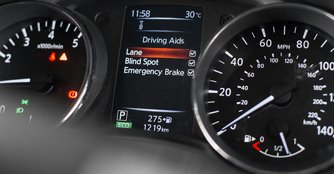
 Forward Emergency Braking detects potential obstacles directly in front of the car and assists in avoiding frontal collisions
Forward Emergency Braking detects potential obstacles directly in front of the car and assists in avoiding frontal collisions
Is it all that good?
If we had to nitpick, our biggest gripe with the Pulsar would have to be the brakes. They have to be depressed a fair bit before they start biting, not something you'd want to experience in a family car.
Additionally, build quality in the Pulsar is on the down side, with plasticky materials filling throughout the cabin. Nonetheless, we reckon superficial imperfections shouldn't be a deal breaker for the Pulsar.
Staying alive for the daily drive
The Pulsar is not a particularly fun car to drive. It does, however, keep an eye out for you and your loved ones.

Under Nissan's Safety Shield concept, the Pulsar boasts a total of six airbags (dual front, side and curtain), which come standard in both trims.
It also comes with Forward Emergency Braking, which detects potential obstacles directly in front of the car and assists in avoiding frontal collisions with pedestrians and vehicles.
Other standard safety features include Electronic Brake Force Distribution, Vehicle Dynamic Control and an Anti-lock Braking System with Brake Assist.

Is it all that good?
If we had to nitpick, our biggest gripe with the Pulsar would have to be the brakes. They have to be depressed a fair bit before they start biting, not something you'd want to experience in a family car.
Additionally, build quality in the Pulsar is on the down side, with plasticky materials filling throughout the cabin. Nonetheless, we reckon superficial imperfections shouldn't be a deal breaker for the Pulsar.
King of the concrete jungle?
The Pulsar is powered by the same 1.2-litre DIG-T engine in the Qashqai, which produces 114bhp and 165Nm of torque, and is mated to Nissan's Xtronic CVT transmission.
This, coupled with a 20kg lighter kerb weight than the Qashqai, allows the Pulsar to navigate through the city with relative ease and make light work of heavy traffic.
Hard acceleration and overtaking in the Pulsar require the engine to work harder but once it gets cruising, you'll discover a quiet and refined cabin with barely a peep from the outside.
The car responds better to gentle throttle inputs, which shows in the smoothness of the transmission and a well-mannered engine at lower revs. The smaller engine and CVT also help give it an edge in terms of fuel economy.
Soft suspension makes for a comfortable ride and soaks up all but the roughest bumps on the road. The Pulsar also handles itself well and steers confidently but the wheel lacks feedback and body roll is prominent round corners.
Yay or nay?
If you're in the market for a sprightly, more fun-to-drive Japanese hatchback, we recommend something like the Honda Jazz.
But if you prioritise practicality over performance, the Nissan Pulsar is a perfectly good, albeit a bit boring, daily driver. It offers plenty of space, great fuel economy and comes with a number of safety features. The comeback kid is definitely one to watch out for.
The Pulsar is powered by the same 1.2-litre DIG-T engine in the Qashqai, which produces 114bhp and 165Nm of torque, and is mated to Nissan's Xtronic CVT transmission.
This, coupled with a 20kg lighter kerb weight than the Qashqai, allows the Pulsar to navigate through the city with relative ease and make light work of heavy traffic.
Hard acceleration and overtaking in the Pulsar require the engine to work harder but once it gets cruising, you'll discover a quiet and refined cabin with barely a peep from the outside.
The car responds better to gentle throttle inputs, which shows in the smoothness of the transmission and a well-mannered engine at lower revs. The smaller engine and CVT also help give it an edge in terms of fuel economy.
Soft suspension makes for a comfortable ride and soaks up all but the roughest bumps on the road. The Pulsar also handles itself well and steers confidently but the wheel lacks feedback and body roll is prominent round corners.
Yay or nay?
If you're in the market for a sprightly, more fun-to-drive Japanese hatchback, we recommend something like the Honda Jazz.
But if you prioritise practicality over performance, the Nissan Pulsar is a perfectly good, albeit a bit boring, daily driver. It offers plenty of space, great fuel economy and comes with a number of safety features. The comeback kid is definitely one to watch out for.
What We Like
Plenty of cabin space
Spacious 385-litre boot
Respectable 14km/L fuel economy
Useful safety features
What We Dislike
Plasticky materials throughout the cabin
Brake modulation can be improved
I wasn't around when the last iteration of the Nissan Pulsar hit our shores. However, if it was anything like the latest generation model that we drove recently, I'd reckon it would have been a pretty big hit.
The Nissan Pulsar 1.2 DIG-T is by no means a driver's car, nor is it the most luxurious. But considering factors such as increasing COE premiums and rising petrol prices, the Pulsar hits the spot for the average joe.
Paving the way for the everyday
Going up against the likes of the Volkswagen Golf and the Ford Focus, the Pulsar boasts practicality and everyday driveability in a relatively affordable package.
Nissan is offering the Pulsar in two trims. The Lite version comes in at $103,300 (as of 20th January 2017) while the Premium comes with leather upholstery and GPS navigation for an additional $3,000.
What impresses me the most is the Pulsar's cabin space. At over 1.8m tall, I've met my fair share of claustrophobic cars and unlike some of them, rear seats in the Pulsar don't require taller occupants to have contortionist-like flexibility.
The seats aren't too shabby either. The front row provides sufficient lumbar support for those long drives while leather upholstery in the Premium model we drove feels soft to the touch.
The Nissan Pulsar 1.2 DIG-T is by no means a driver's car, nor is it the most luxurious. But considering factors such as increasing COE premiums and rising petrol prices, the Pulsar hits the spot for the average joe.
Paving the way for the everyday
Going up against the likes of the Volkswagen Golf and the Ford Focus, the Pulsar boasts practicality and everyday driveability in a relatively affordable package.
Nissan is offering the Pulsar in two trims. The Lite version comes in at $103,300 (as of 20th January 2017) while the Premium comes with leather upholstery and GPS navigation for an additional $3,000.
What impresses me the most is the Pulsar's cabin space. At over 1.8m tall, I've met my fair share of claustrophobic cars and unlike some of them, rear seats in the Pulsar don't require taller occupants to have contortionist-like flexibility.
The seats aren't too shabby either. The front row provides sufficient lumbar support for those long drives while leather upholstery in the Premium model we drove feels soft to the touch.
Still, ventilated seats would have been a much nicer addition, as heated seats in our test car didn't do much to prevent us from spontaneously combusting in the Singapore heat.
Seating five full-grown adults in comfort isn't all this hatch can do, a 385-litre boot (five litres more compared to the Golf) ensures all your luggage is conveniently stowed away so your passengers can enjoy the ride.
If you're riding alone and require the additional space, the Pulsar's rear seats fold down to allow for a total of 1,395 litres of storage capable of accommodating anything from golf bags to a week's worth of groceries.
The comeback kid has a few tricks up its sleeve
A nifty little feature shows up on the Pulsar's 5.0-inch TFT information display every now and then in the form of a pop-up window, which displays the amount of accumulated CO2 saved due to the vehicle's auto start/stop function.
Nissan's Advanced Drive-Assist Display also allows fuel economy, average speed and audio information to be viewed at a quick glance.
Seating five full-grown adults in comfort isn't all this hatch can do, a 385-litre boot (five litres more compared to the Golf) ensures all your luggage is conveniently stowed away so your passengers can enjoy the ride.
If you're riding alone and require the additional space, the Pulsar's rear seats fold down to allow for a total of 1,395 litres of storage capable of accommodating anything from golf bags to a week's worth of groceries.
The comeback kid has a few tricks up its sleeve
A nifty little feature shows up on the Pulsar's 5.0-inch TFT information display every now and then in the form of a pop-up window, which displays the amount of accumulated CO2 saved due to the vehicle's auto start/stop function.
Nissan's Advanced Drive-Assist Display also allows fuel economy, average speed and audio information to be viewed at a quick glance.
Speaking of savings, we managed to get an average fuel consumption figure of 14km/L out of its claimed 19.6km/L, which is a respectable figure in real-world conditions.
Staying alive for the daily drive
The Pulsar is not a particularly fun car to drive. It does, however, keep an eye out for you and your loved ones. Under Nissan's Safety Shield concept, the Pulsar boasts a total of six airbags (dual front, side and curtain), which come standard in both trims.
It also comes with Forward Emergency Braking, which detects potential obstacles directly in front of the car and assists in avoiding frontal collisions with pedestrians and vehicles.
Other standard safety features include Electronic Brake Force Distribution, Vehicle Dynamic Control and an Anti-lock Braking System with Brake Assist.
Is it all that good?
If we had to nitpick, our biggest gripe with the Pulsar would have to be the brakes. They have to be depressed a fair bit before they start biting, not something you'd want to experience in a family car.
Additionally, build quality in the Pulsar is on the down side, with plasticky materials filling throughout the cabin. Nonetheless, we reckon superficial imperfections shouldn't be a deal breaker for the Pulsar.
Staying alive for the daily drive
The Pulsar is not a particularly fun car to drive. It does, however, keep an eye out for you and your loved ones. Under Nissan's Safety Shield concept, the Pulsar boasts a total of six airbags (dual front, side and curtain), which come standard in both trims.
It also comes with Forward Emergency Braking, which detects potential obstacles directly in front of the car and assists in avoiding frontal collisions with pedestrians and vehicles.
Other standard safety features include Electronic Brake Force Distribution, Vehicle Dynamic Control and an Anti-lock Braking System with Brake Assist.
Is it all that good?
If we had to nitpick, our biggest gripe with the Pulsar would have to be the brakes. They have to be depressed a fair bit before they start biting, not something you'd want to experience in a family car.
Additionally, build quality in the Pulsar is on the down side, with plasticky materials filling throughout the cabin. Nonetheless, we reckon superficial imperfections shouldn't be a deal breaker for the Pulsar.
King of the concrete jungle?
The Pulsar is powered by the same 1.2-litre DIG-T engine in the Qashqai, which produces 114bhp and 165Nm of torque, and is mated to Nissan's Xtronic CVT transmission.
This, coupled with a 20kg lighter kerb weight than the Qashqai, allows the Pulsar to navigate through the city with relative ease and make light work of heavy traffic.
Hard acceleration and overtaking in the Pulsar require the engine to work harder but once it gets cruising, you'll discover a quiet and refined cabin with barely a peep from the outside.
The car responds better to gentle throttle inputs, which shows in the smoothness of the transmission and a well-mannered engine at lower revs. The smaller engine and CVT also help give it an edge in terms of fuel economy.
Soft suspension makes for a comfortable ride and soaks up all but the roughest bumps on the road. The Pulsar also handles itself well and steers confidently but the wheel lacks feedback and body roll is prominent round corners.
Yay or nay?
If you're in the market for a sprightly, more fun-to-drive Japanese hatchback, we recommend something like the Honda Jazz.
But if you prioritise practicality over performance, the Nissan Pulsar is a perfectly good, albeit a bit boring, daily driver. It offers plenty of space, great fuel economy and comes with a number of safety features. The comeback kid is definitely one to watch out for.
The Pulsar is powered by the same 1.2-litre DIG-T engine in the Qashqai, which produces 114bhp and 165Nm of torque, and is mated to Nissan's Xtronic CVT transmission.
This, coupled with a 20kg lighter kerb weight than the Qashqai, allows the Pulsar to navigate through the city with relative ease and make light work of heavy traffic.
Hard acceleration and overtaking in the Pulsar require the engine to work harder but once it gets cruising, you'll discover a quiet and refined cabin with barely a peep from the outside.
The car responds better to gentle throttle inputs, which shows in the smoothness of the transmission and a well-mannered engine at lower revs. The smaller engine and CVT also help give it an edge in terms of fuel economy.
Soft suspension makes for a comfortable ride and soaks up all but the roughest bumps on the road. The Pulsar also handles itself well and steers confidently but the wheel lacks feedback and body roll is prominent round corners.
Yay or nay?
If you're in the market for a sprightly, more fun-to-drive Japanese hatchback, we recommend something like the Honda Jazz.
But if you prioritise practicality over performance, the Nissan Pulsar is a perfectly good, albeit a bit boring, daily driver. It offers plenty of space, great fuel economy and comes with a number of safety features. The comeback kid is definitely one to watch out for.
Also read our comparison article on:
Ford Focus Hatchback vs Nissan Pulsar vs Peugeot 308Car Information
Nissan Pulsar 1.2 DIG-T Premium (A)
CAT A|Petrol|19.6km/L
Horsepower
85kW (114 bhp)
Torque
165 Nm
Acceleration
-
This model is no longer being sold by local distributor
All Used Nissan PulsarThank You For Your Subscription.























